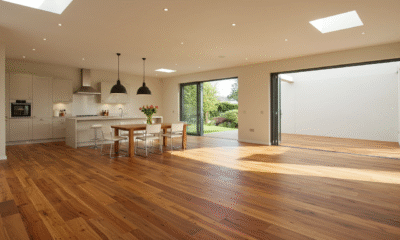The trend toward ecological sustainability is heating up today, just as the Earth is. Although families don’t contribute significantly to polluting the environment in the same way as large industries do, there are various activities that a homeowner may initiate or undertake to make their home eco-friendlier and produce less carbon footprint.
It’s critical to make changes where feasible, and your home is where you have influence; so why not be at the forefront of much-needed change? However, not every house has been designed to be eco-friendly.
Lucky for you this post will highlight several sustainable home additions that can help you minimize energy consumption and live more sustainably. Please keep in mind that eco-friendly home add-ons aren’t only excellent for the Earth but also good for your wallet and loved ones as well. Keep on reading to learn more.
1. Install Solar Panels
Installing solar panels is perhaps the most effective way to ensure your house is eco-friendly. You can’t ignore the fact that installation isn’t cheap or simple, yet solar panels positively affect your electricity costs and environmental imprint.
On the plus side, several governments worldwide provide incentives to reduce installation costs. You can even lease solar panels in some cases which saves you a lot on upfront expenses. Whatever choice you prefer, be sure first to do a power analysis as well as other productivity increases. This ensures that your solar panels can manage the load for your home’s requirements.
When fully functioning, a solar panel system can charge various appliances, including solar generators, and save you hundreds of dollars in energy costs each year for the rest of its decades-long lifespan. You’ll be able to save even more money if energy prices go up. In fact, do you know you can sell your excess power to the electricity grid or your nearest neighbors? It’s a win-win situation for you.
2. Use Energy-saving Light Bulbs
To begin with, while energy-saving light bulbs have been around for several decades, it’s only recently that many have developed an interest in them and begun to research their efficiency and how they may assist in cutting costs around the house.
It’s also worth mentioning that people complained that energy-efficient light bulbs didn’t provide enough light or took too long to illuminate an area. Nevertheless, technological improvements have improved them, and there’s no better time than now to make the transition to greener living conditions. They’ll greatly reduce your power expenses and will not need to be replaced frequently.
3. Utilize Less Water
You may wonder how utilizing less water leads to sustainability. It’s debated which is preferable between a tub and a shower, yet, estimating the amount of water that flows into a bathtub is straightforward. But a quick shower may be more effective. Using a tub, you may estimate the water level by drawing a line around it. This is an old wartime trick, but it’s a fantastic way to monitor how much water you use in the tub.
Meanwhile, if you use a shower, you may install a waterproof timer. At the set time, the device cuts off the flow of water. Because it has safety locks, a waterproof timer will help you save water, especially if you have children who like to blow bubbles in the shower.
In addition, you can install an aerated shower head. This one is quite cool; it combines air and water to produce massive drops of water. The ensuing sensation is that there’s a lot more water than there is. You’ll have a shower head that provides a thrilling experience but uses less water.
It’s hard to imagine that your toilet uses so much water, but the reality is that it does. Yet this is the most natural place in your home to conserve water. You can acquire and install an inflated balloon in the cistern. The inflating balloon occupies space, allowing the cistern to refill quickly and with less water.
Lastly, check out conservation organizations, your local government, and the water department for ideas. They occasionally help water-saving efforts by providing free tools and information to homeowners like you.
4. Buy A Water Filter
Buying drinking water isn’t always the best option, especially when junkyards are still overrun with waste plastic bottles. Why not install a water filter and help preserve the environment by minimizing waste? It’s an eco-friendly addition that will provide your home with clean water to consume and use. Lastly, water filters are simple to install and generally affordable.
Final Thoughts
The world is progressively realizing the need to be environmentally friendly, and you’ll see people doing simple things like reprocessing garbage. These are only a few methods to make your home eco-friendlier. But when looking at the broad picture, there’re several approaches, both large and small, that’ll successfully educate the world about the environment and inspire a more sustainable way of living.


 Environment10 months ago
Environment10 months agoAre Polymer Banknotes: an Eco-Friendly Trend or a Groundswell?

 Environment12 months ago
Environment12 months agoEco-Friendly Home Improvements: Top 7 Upgrades for 2025

 Features9 months ago
Features9 months agoEco-Friendly Cryptocurrencies: Sustainable Investment Choices

 Features11 months ago
Features11 months agoEco-Friendly Crypto Traders Must Find the Right Exchange




























